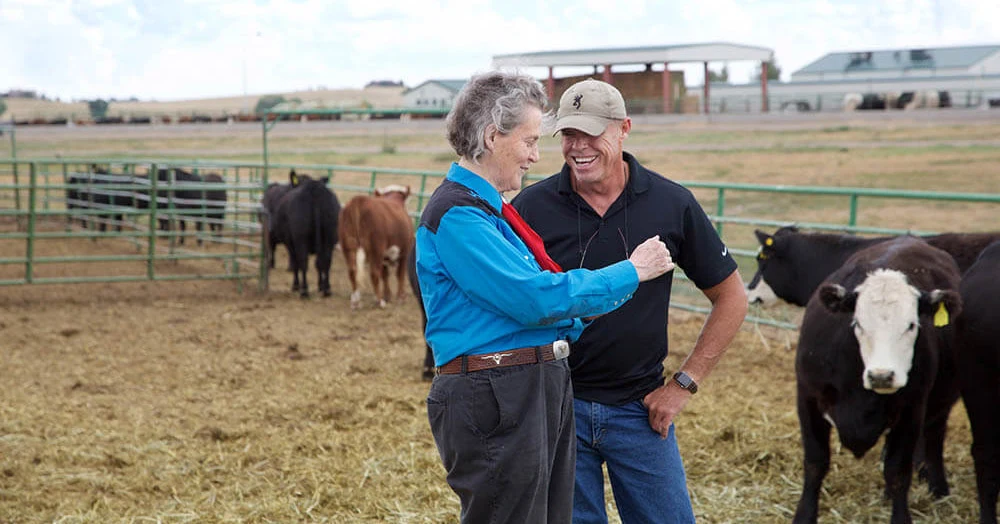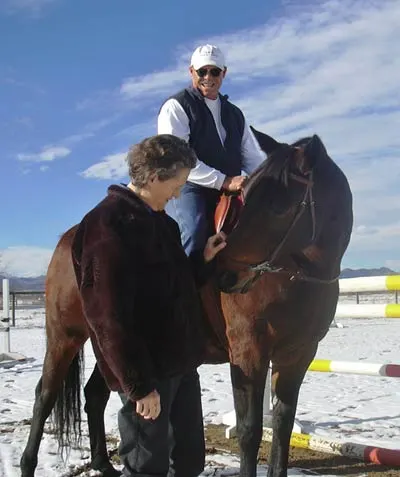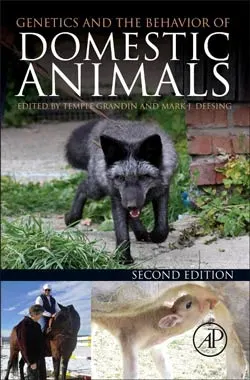How a horse trainer got to publish research with Temple Grandin
June 3, 2013
By Alison Bert, DMA

Dr Temple Grandin talks shop with her research and business partner Mark Deesing after they teach a class together at Colorado State University. (Photo by Alison Bert)
Mark Deesing talks about what he’s learned in the field — and how Dr Temple Grandin helped him turn it into scientific knowledge
Since high school, Mark Deesing has worked closely with horses, shoeing them and later training hunter/jumpers. His experience led him to observe that the position of the hair whorls on their foreheads often correlates with their temperament.
“I first heard of it in folklore,” he said. "American Indians believed they could predict the temperament of a horse by the whorl on its head. “Beduoin tribesman valued hair whorls as a means of predicting personality and performance traits in horses 2,000 years ago. And the Chinese have looked at hair whorls in their children for thousands of years.”
Over time, he started to see a pattern. “I saw that some trends existed in that the higher the whorl was on the forehead, the more high-strung and fearful the horse was,” Deesing said. “But I wasn't completely convinced because it doesn't hold true all the time.”
That was three decades ago in his hometown of Salt Lake City, Utah. After high school, he didn't have the money to attend college, so he started working as a horse shoer, or farrier, as they call it in the business.

Mark J. Deesing
“At the time, I didn’t really understand the interaction between genetic influences and environment and how those forces interact to shape behavior,” he said.
For example, he pointed out that horses with the high hair whorls are not always high strung. “If he’s raised gently, his true temperament will be masked by experience — but it's only masked and not changed by experience,” he said. “That’s another thing that we’ve learned from the neuroscience literature. If you expose an animal to novelty, his true temperament shows. That’s because neurosystem reactivity is genetically based.”
Soon he noticed a more consistent correlation that convinced him there was something to this theory of hair whorls. And it changed the way he worked: As a farrier, you shoe both sides of a horse … and they are often easier to handle on one side or the other. Most horses exhibit this kind of behavior. When they resist having someone pick up their feet, I found that most of the time, the hair whorl will be on the same side the horse was difficult.

Hair whorl chart from Genetics and the Behavior of Domestic Animals, Second Edition, Chapter 7
Also, every horse trainer will tell you that horses prefer to turn in one direction and are reluctant to turn in another direction. There are many examples of handedness in a horse.
This observation became very useful for my ability to approach a horse and train it. If I saw the whorl was on the left side of the horse's head and it gave me some trouble, I would switch sides and go to the other side. That tended to make my job safer because usually by the time I got through shoeing the easy side, the horse was more cooperative on the difficult side.
Getting support for his ‘hair-brained’ idea
Deesing spent the next 10 years studying this phenomenon on his own. "I hardly shared it with anyone because I thought they'd think I was crazy," he said. "But I was determined to get some support and maybe even go to college."
He contacted professors around the United States to no avail. "One professor kicked me out of his office and told me it was a stupid hair-brained idea," he recalled and laughed.
Then in 1993, a professor at Colorado State University invited him to speak to his equine behavior class. Although the professor was not convinced of his ideas, one of his students was, Deesing said. A graduate student named Mary Tanner approached him after class and asked him what he wanted to do with his ideas

Classification of hair whorl positions on the forehead of the horse. (a) High left, (b) High right, (c) middle (d) low
“I said, ‘I want to do research; I want to study hair whorls, or I want someone to do the research if I don’t do it myself.’
“And she said, ‘I know somebody you ought to meet.’
An impromptu meeting with Temple Grandin
“Mary walked me across the street to the animal science building and introduced me to Temple. It was a complete stroke of luck, because I didn't know Temple — I'd never even heard of her.
“I remember that first conversation like it was yesterday,” he said:
I talked straight for 45 minutes, and Temple never once made eye contact with me. She was fumbling with papers and looking at her mail and all this other stuff that just made me think that, ‘Oh, God, she’s not even listening.’ I was totally frustrated.
Then finally she looked up and said to me, 'I don't know what the hell you're talking about but it's interesting, and I'm in. What do you want to do? How do you want to study this?’ I was just blown away.
Over the next few months, they talked on the phone. Deesing realized that to get this project underway, he would have to be there. "So I gave up everything I had worked for for 15 years in Salt Lake and moved over here and started working with Temple, doing research."
When he shared his observations with Dr Grandin about hair whorls and animals' fear tendencies, he didn't know the underlying cause, and she hadn't heard of anything about this. So she gave him his first assignment.

Temple Grandin visits Mark Deesing on his ranch. He is sitting on his horse Amy, a German Warmblood show jumper. This photo is on the front cover their book. (Photo by Kelly Mozetta)
'Has anyone done this before?'
"The first chore she gave me was to go to the library and study and find out if anybody else had ever looked at something like this – and also to find out about the developmental process of hair whorls," he said. "Well right away we struck gold in that pediatricians had looked at hair whorls in children for decades."
Deesing explained that people all have hair whorls, or cowlicks, on the backs of their heads, and pediatric studies have shown that children with various developmental disabilities often have abnormal scalp hair patterns.
"What they found was that the hair and the brain formed from the same fetal cell layer," Deesing said. "So early in gestation – about 10 weeks when the brain is beginning to form – hair follicles form on the scalp at the same time. As the brain grows and forms, hair whorls are interpreted as a point of stretch over the underlying structures of the brain."
Those early studies gave Temple the motivation to proceed with his idea. But instead of using horses – which are hard to find in larger numbers with the same experiences and genetics – Dr. Grandin suggested they use cattle.
Science confirms observations
Their first project was a double-blind study observing the level of agitation cattle exhibit in a squeeze chute during routine husbandry procedures, in relation to the animal’s hair whorl. It was published in Elsevier’s Applied Animal Behavior Science journal in 1995.
Their second study looked at the position of the hair whorls in relation to right- or left- “handedness” in cattle — observing 1,670 dairy cows over a year to see which turned to the left and which to the right when entering the milking parlor. Tanner, who introduced them, was one of the co-authors. The abstract was published in the The Journal of Animal Science in 1994.
At the heart of this research is the significance of specialized functions of brain's cerebral hemispheres, Deesing explains:

Once thought to be a uniquely human trait, specialized function of the cerebral hemispheres is common in both vertebrate and invertebrate species. In essence, the left side of the brain is geared toward social interaction and food finding (approach behavior); the right side is geared to detect danger (avoidance behavior). These specialized functions evolved in animals such as horses and cattle, allowing them to graze and simultaneously be on guard for danger.
Both studies confirmed Deesing's observations.
In 1994, they also reviewed data and studies on associations between hair whorl patterns and performance in horses. They found in increase in double hair whorls on horses that were more reactive — but also with those who were high performers. In fact the percentage of double whorls in racing and jumping horses was nearly double the percentage found in all other samples they found in the literature.
Deesing went on to work with Dr. Grandin on the first edition of Genetics and the Behavior of Domestic Animals, published in 1997 — and the second edition, which will be released tomorrow.
These and other findings about hair whorls are detailed in Chapter 7, “Behavior Genetics of the Horse (Equus caballus),” for which Deesing is the lead author. The chapter delves into the science of hair whorls in horses, cattle, guide dogs and humans — and the practical use of this knowledge.
Practical applications for animal training
Deesing stressed that their scientific observations have important practical applications. For example, in Chapter 7, there's a section on guide dogs and hair whorls and “handedness."
Dogs are both left- and right-handed, he explained, and this has an influence on their selection as guide dogs for the blind because the dogs are trained to work on a person's left side. He cited a 2012 study in the Journal of Veterinary Behavior: Clinical Applications and Research that showed that success was higher for right-preferent and ambidextrous dogs, and that the presence of a whorl on the dog's left side of the head and thorax was associated with a right visual bias.
A dominant right eye is preferable because the dog's right eye is on the side of the person he is guiding, whereas when the left eye is dominant, the dog can be more easily distracted by things going on to its left.
“That's one example of how practical this work is," he said. “It costs thousands and thousands of dollars to teach a dog to be a guide dog for the blind, and now they have a way to look at the hair whorls on the dog to predict what eye is dominant and which dogs are going to be the best suited for this type of training."
Also, he said, this knowledge can help horse trainers make sure their animals are “balanced." With show-jumping horses, for example, the horses have to making quick jumps to both the right and the left. Knowing the weak side of the horse, which can be determined by the hair whorl, would enable him to spend more time on that side to balance the horse out.
Ultimately it comes down to fear: “If horses are difficult to shoe on one side, it's usually fear-related. They're afraid of having you over on that side. And if they don't turn well going left or right on a show-jumping course, it's usually because they are afraid of the novelty and want to keep their good side to the outside," he explained.
A job that pays the rent
Doing academic research didn't pay the bills, however, so Deesing decided he would to return to Salt Lake City and go back to working as horse trainer.
“I mentioned that to Temple one day and she said, ‘Oh no you’re not — you’re staying right here.’ She said, ‘What’s going to take to keep you here?’ and I said, ‘Well a job would be nice.’”
In addition to his behavior consulting work with horses and cattle, Dr Grandin taught him to do design work for her company Grandin Livestock Handling Systems. Now he travels around the world as a designer and consultant “doing the work that Temple doesn't have time to do anymore.” He designs new facilities and troubleshoots existing facilities to make sure they meet animal welfare standards, using an objective auditing system Dr. Grandin developed for the American Beef Industry. He also trains handlers how to use the facilities to keep animals calm, including basics like where to stand and how to move.
Deesing, who was headed off to have lunch with Dr Grandin after this interview, credits her with enabling him to realize a dream by researching his ideas scientifically.
“I learned what I know in the field,” he said, “and Temple always defended me by saying that people who work in the field often observe things that scientists sitting in offices don't see.
“For me it's just been something I have always wanted to do. I just set out to know whether I was right — I didn't care about anything else. But it's turned out to be a very valuable observation that has a lot of practical applications.”
Contributor

ABD
